Calorie consumption calculation
| Kind of activity: | Time: | Energy consumption: |
| Total: | 0 kcal | |
Metabolism cannot exist independently without consuming calories, and vice versa.
Metabolic processes that occur in the human body are directly related to the so-called energy exchange. The unit of energy is the calorie. Heart, respiratory system, liver and kidneys - these internal organs account for the greatest energy costs. They are not interrupted even at rest. Scientists have found that in one hour, every kilogram of the body burns 1 kcal, which in total gives us about 1800 kcal per day.
These figures are very ambiguous, as they depend on many components. To keep your body in good shape, consume the maximum possible amount of kilocalories - resort to active physical activities so that the muscle work is very intense. An online table and flow analyzer will help you calculate all the necessary data.
Energy consumption when walking
The most energy is consumed during heavy loads, active training, and professional sports. But this suits few people. But walking is accessible even to city residents. This is a gentle, gentle, but at the same time effective way to increase daily calorie consumption and lose weight.
Energy consumption when walking depends on many factors:
- Human weight. The relationship is direct: the larger the mass, the harder you will have to work to move it and the more energy you need for this.
- Movement speed. Fast walking promotes more active burning of fat deposits, so you should not overestimate your strength and start running.
- Additional loads. Climbing stairs or rough terrain, carrying a heavy backpack, swinging your arms and turning around - all this also increases energy costs.
- External factors, including weather. It is important to understand that in the heat more water comes out, which is why weight loss is noticeable. But it is in the cold that there is an increased consumption of fat, since calories are needed for steps and heating at the same time.
Basic values are calculated when moving on the plain with an average walking speed of 4-5 km/h. With a body weight of 60 kg, 60 minutes of such a walk will consume 220-260 kcal, and with a weight of 75 kg, the consumption will be 280-310 kcal.
To accurately calculate how many calories are burned when walking in 1 hour, it is better to use online calculators.
Online calculator for calculating calorie consumption
This counter is very convenient to use, since the counting is completed in a fraction of a second:
- indicate body weight;
- type of activity (sports, fitness, sedentary work, entertainment);
- time spent;
- the system will calculate the result.
When one gram of protein is broken down, 4.1 kcal is released, fat – 9.3, carbohydrates – 4.1. Every second of our lives, we lose energy by releasing heat into the environment. The intensity of heat exchange depends on activity or inactivity.
On average, the daily energy expenditure of the average representative of the stronger sex fluctuates around 2500-2700 kilocalories, the weak - 2000-2200. But all this is very approximate data, because a spread of 200 units can cause the appearance of fat deposits.
It is better to use a modified version of the Mifflin-San Geor daily calorie consumption formula, which takes into account your parameters, level of activity - and therefore provides more accurate data. When counting calories for weight loss, weight consumption is determined according to height:
- for men: (10 x weight (kg) + 6.25 x height (cm) – 5 x age (g) + 5) x A
; - for women: (10 x weight (kg) + 6.25 x height (cm) – 5 x age (g) – 161) x A
, where:
A1 – minimum activity, =1.2;
A2 – weak, =1.375;
A3 – average, =1.55;
A4 – high, =1.725;
The arithmetic of the numbers is quite simple: when losing weight, you should increase calorie consumption in relation to consumption, when gaining weight - vice versa, and with a normal lifestyle these indicators are equal. The balance is contained in the elementary equation for measuring calorie expenditure:
Nutritional value of foods eaten = energy loss
To calculate your daily kcal consumption, you can also use a calorie consumption analyzer.
The main source of loss of extra pounds per day, for both women and men, is sports. It improves well-being, has a positive effect on health, muscle tone, coordination, balance, reaction, promotes the development of logical thinking and helps get rid of hated centimeters.
Even the most insignificant effort or movement brings you one step closer to your goal, and a long period of training will allow you to do this by leaps and bounds, because the main consumption of calories by a person occurs precisely during physical activity. To make it easier to determine how much you spend per day for certain exercises, we suggest using the following table of daily calorie consumption :
| Activity (calorie consumption per 1 hour), kcal | per 1 kg of weight | for 80 kg weight | for 70 kg weight | for 60 kg weight | for 50 kg weight |
| walk | 4,5 | 360 | 315 | 270 | 225 |
| during Nordic walking | 5,7 | 456 | 399 | 342 | 286 |
| when walking 5 km/h | 4,5 | 360 | 315 | 270 | 225 |
| high intensity dancing (high calorie consumption) | 6,9 | 554 | 485 | 416 | 346 |
| when riding a bicycle (driving 20 km/h) | 7,7 | 617 | 540 | 463 | 386 |
| breaststroke swimming | 10,6 | 844 | 739 | 633 | 528 |
| when swimming crawl | 8,1 | 651 | 570 | 489 | 407 |
| during water aerobics | 7,6 | 606 | 530 | 454 | 379 |
| spinning a hoop (hula hoop) | 4.4 | 352 | 308 | 264 | 221 |
| on an exercise bike | 7,4 | 592 | 518 | 444 | 369 |
| treadmill 12 km/h | 11,4 | 912 | 798 | 684 | 570 |
| on an elliptical trainer (health disk) | 7,4 | 592 | 518 | 444 | 369 |
| on the rowing machine | 7,4 | 592 | 518 | 444 | 369 |
| jumping | 10,1 | 808 | 707 | 606 | 505 |
| squats | 5,6 | 448 | 392 | 336 | 280 |
| jumping rope | 7,7 | 617 | 540 | 463 | 386 |
| rowing | 3,0 | 240 | 270 | 180 | 150 |
| step aerobics intensive | 10,6 | 848 | 742 | 636 | 528 |
| aerobics intense | 7,4 | 592 | 518 | 444 | 369 |
| crossfit | 11,9 | 956 | 833 | 714 | 595 |
| bodyflex | 10 | 800 | 700 | 600 | 500 |
| yoga static | 3,2 | 256 | 224 | 192 | 160 |
| Pilates (average calorie expenditure) | 4,9 | 392 | 343 | 294 | 245 |
| roller skating | 4,4 | 354 | 310 | 266 | 221 |
| riding a scooter | 5,3 | 424 | 371 | 318 | 264 |
| badminton | 6,9 | 554 | 485 | 416 | 346 |
| football | 6,4 | 514 | 450 | 386 | 321 |
| climbing the stairs | 12,9 | 1029 | 900 | 771 | 643 |
No less effective exercises include:
- bench press;
- cardio exercises;
- power training;
- burpee (with 1 approach, calorie consumption - 1.43);
- bar;
- rocking the press;
- pull-up exercises;
- push-ups and push-up exercises;
- in various other sports.
It would be rational to plan your individual training process, which will correspond to your lifestyle, capabilities and skills (this means highly coordinated sports). Join a gym, fitness class or swimming pool, go for a morning jog (you can even get results from jogging and running in place) or exercise right at home. At the same time, you can achieve results faster in the gym using simulators. The most important thing is to lead an active lifestyle!
Sports and physical exercise are effective, but in addition to special loads, energy is lost during various types of activities - even during ordinary daily activities and household chores that we did not even suspect:
- eating;
- hygiene;
- talking on the phone;
- working on a computer;
- making the bed;
- Hair Styling;
- dressing/undressing;
- taking a bath;
- Reading books.
The base and average calorie consumption per day is, on average, lower from such activities than from working out in the gym. And yet, such seemingly insignificant actions also help the body to stay in good shape! The data is shown in the table:
| Activity (calorie consumption per 1 hour), kcal | per 1 kg of weight | for 80 kg weight | for 70 kg weight | for 60 kg weight | for 50 kg weight |
| lying | 1,1 | 88 | 77 | 66 | 55 |
| sleep (during sleep) | 0,6 | 51 | 45 | 39 | 32 |
| at rest | 1,0 | 80 | 70 | 61 | 51 |
| during active sex | 2,1 | 171 | 150 | 129 | 107 |
| when climbing stairs | 12,9 | 1029 | 900 | 771 | 643 |
| cleaning | 2,7 | 214 | 188 | 161 | 134 |
| when driving a car | 1,4 | 115 | 101 | 87 | 72 |
| being in the bathhouse | 3,1 | 248 | 220 | 186 | 155 |
| being in cold water | 1,2 | 96 | 84 | 72 | 60 |
| during sedentary work | 1,1 | 86 | 75 | 54 | 44 |
| during mental activity | 0,13 | 10,4 | 8,8 | 7,8 | 6,5 |
| office work | 1,2 | 99 | 87 | 75 | 62 |
| during pregnancy | 2,08 | 166,4 | 145,6 | 124,8 | 104 |
| while breastfeeding | 2,0 | 163 | 142 | 122 | 101 |
Often, in order to bring yourself back to normal, it is enough to simply use the above tables of basic and average consumption, formulas, and a calculator. And understand that after spending a certain amount of energy, we will be able to eat food, the energy value of which coincides with the energy spent (for those who want to lose weight, come Links to authoritative sources
Increase in consumption
The type of work, as well as his gender and age, determine the energy requirements per day. The norms for men and older people are always lower.
- For those engaged in mental work, 1800-2000 kcal are required for women and 2100-2500 kcal for men per day.
- If the work can be characterized as light physical, then the energy requirement is 2100-2200 for the fair sex and 2500-2800 for the stronger sex.
- For average physical labor, you need 2500-2600 kcal for women and 3000-3300 for men daily.
There are quite detailed studies that show exactly how many calories are burned in a particular type of activity.
Energy consumption for different activities is shown in the table.
For example, during sleep and rest without movement, 1-1.5 kcal are spent every minute, and when washing floors and windows, 4-5 kcal are already spent. From here we can draw a simple conclusion: the more a person moves, the more energy he spends. If the body receives less “fuel” per day than it needs, it takes it from reserves - it uses up fat deposits.
There are many techniques to increase the intensity of exercise: weighting, swinging your arms, walking in heels, moving with sticks and even on crutches. Their main goal is to use as many muscles as possible and increase the load. You can combine walking with tension in your buttocks and abs, and do inserts of steps with your knees raised high.
Many people are interested in the question, how many calories are burned when walking in place? In fact, this is a very intense exercise due to the pace and knees that rise high. It destroys 58 kcal in 5 minutes.
Hand movements
This is the simplest and most accessible way to everyone. It will help you work out your upper body and stretch your shoulders when sitting at the computer for a long time. It is enough to bend your elbows at an angle of 90 degrees and move them back and forth in rhythm with steps.
https://www.youtube.com/watch?v=0h23mQbJcnc
Some trainers recommend putting extra weight on your arms or legs, while others recommend wearing a backpack filled with bottles of water or sand. This way there is less chance of damaging your legs.
The weight of the “additional weight” is of great importance: the larger it is, the faster fat will be burned. If you carry a load of 10 kg with you, this will increase the effectiveness of training by 13%, with 20 kg it will increase by 31%. If the number of weights is significant and their mass is 30 kg, this will increase the result by 60%.
Even regular ski poles provide intense movement. They are good for both children and older people. This simple equipment increases the effectiveness of classes by 40%. In winter, it is good to practice skiing; it is 2.5-3 times better at losing excess weight.
Running trainer
A treadmill is a good alternative to outings when you need to exercise and it’s raining or snowing outside. Moreover, the simulator allows you to adjust the speed from 4 to 6.5 km/h. If desired, exercises on the stepper can be supplemented with arm swings. There are simpler mechanical exercise machines, as well as elliptical ones, which are suitable for walking, running, and cycling.
Uneven terrain
A flat, smooth road means minimal load. Moving through grass or forest increases costs by 10-15%. If the terrain has a slope, then climbing it uphill increases energy consumption by one and a half times. Trying to get through the snowdrifts is 2 times more effective.
On crutches
If your leg is in a cast, this is not a reason to stop training and move little, otherwise you can gain even more extra pounds. In terms of energy consumption, walking on crutches is equivalent to Scandinavian walking (350 kcal per hour of exercise). But you need to adapt to such equipment, because the load on your hands will be significant.
To lose weight, you don’t have to exhaust yourself with exercise equipment in the gym. Simple walking, if practiced regularly and for long distances, will help bring your weight back to normal. Fresh air and pleasant company in the form of friends or your beloved dog will make classes enjoyable.
How many calories are burned when climbing stairs?
The human body is a complex mechanism. In order for a person to live fully, he needs energy, which is produced from food. The body digests food, receives kilocalories, which are subsequently converted into thermal energy. At the moment, there are many methods that can clearly determine energy consumption for any type of activity.
Fats, proteins and carbohydrates are the main microelements responsible for activity. When there is a lack of energy, the metabolic process slows down and the person feels lethargic. If calories are not consumed, their excess turns into fat. To lose weight, you first need to eat right and know the calorie content of food consumed in order to reduce it by 20%.
Burning calories during physical activity
Regardless of gender or age, the human body must receive the required portion of calories every day. The daily intake is individual for everyone and depends on physical activity. Young people are more active, while middle-aged people lead a more relaxed lifestyle. Also, a person with a sedentary job needs fewer calories, unlike an athlete.
Counting calories is the first step to losing excess weight. Knowing your individual daily requirement, you can calculate the required number of calories per day to start losing weight. You can calculate using a formula or a special online calculator.
The female body needs fewer calories than the male body. This is due to genetics. A woman needs about 2000 kcal per day. If you need to lose weight, subtract 10–20% (500 kcal) from your normal daily intake.
Men have a fast metabolism and tend to lose weight. The daily norm is about 2400 kcal. To lose weight, men and women need to consume 10-20% fewer calories.
Types of Cardio Training
There are many sports for cardio training that have different effects on a person, and burning 500 kcal in 45 minutes of cardio training is quite possible. It is only necessary to load the body gradually in order to adapt it to new loads.
Cardio is beneficial for the heart. Such training develops the cardiovascular and respiratory systems.
Note! Properly selected cardio load and intensity of exercise increases physical capabilities without harming the muscles.
Running is the simplest physical activity, but it is not suitable for everyone. It is necessary to take this sport seriously if you are overweight, have problem joints or have poor physical fitness. Running strengthens the legs, buttocks, abdominal muscles and intercostal muscles. During a jogging walk, your arms work, which contributes to the load on the biceps, triceps and broad back muscles.
Cycling will be an excellent exercise if you have poor physical fitness and are overweight. While riding, the main load goes to the quadriceps. The gluteal muscles, calf muscles and thighs do not remain unloaded.
Swimming is great for people who are overweight and have problem joints.
- muscles of the legs, arms, back, abs;
- joints and ligaments;
- increases endurance;
- has a positive effect on the respiratory system.
During swimming (crawl, breaststroke), oxygen is retained when inhaling, and exhalation occurs under water, in a dense environment. This workout increases lung capacity, which promotes deep breathing and good oxygen saturation.
Aerobics is the best form of cardio exercise for those who find it boring to workout alone at home. Aerobics includes: jumping, stretching, active walking and floor exercises.
Boxing guarantees a good cardio load. To avoid bruises, you can only exercise with a bag. By practicing punches, you can not only learn self-defense, but also have a positive effect on the heart.
Thus, cardio training helps you burn 500 calories in 45 minutes quite effectively.
Walking on stairs: how many calories are burned?
How many calories are burned when climbing stairs is open and proven in numerous studies. 25-30 minute workouts help you easily burn excess fat. Different methods of ascent and descent achieve different goals. If your goal is to lose extra pounds, you need to walk at an accelerated pace. Slow speed increases the load on the buttocks and thighs, which strengthens the muscles well.
Important information! If you experience shortness of breath when walking up stairs, you should consult a doctor. Most likely, it is necessary to strengthen the heart and blood vessels.
Climbing stairs - calories
In an hour of walking up the stairs you can get rid of 500 kcal or 700 grams of weight. At a speed of 60 steps per minute (5th–6th floor), 0.14 kcal is spent per 1 kg of weight, which means a person weighing 100 kg loses 140 kcal per minute. An average person weighing 60–80 kg will get rid of 400–500 kcal by walking up and down stairs for an hour. Naturally, going up and down stairs for an hour is not an easy task, so you need to start with 15 minutes in the first week and gradually increase to forty minutes.
How many calories are burned while walking: formula and calculation example
To calculate how many calories are burned when climbing stairs to the 5th, 9th or 10th floor, you will need the following basic data:
- Own body weight in kilograms (denoted by the letters “MT”);
- The height of one step of the staircase in meters (in the formula it corresponds to the designation “BC”);
- The number of steps on a flight of stairs between two adjacent floors (denoted by the abbreviation “KS”);
- The number of floors in the house (briefly denoted “KE”).
Formula for calculating energy consumption (“RE”): RE=MT*10*VS*KS*(CE-0.5).
Attention! Subtract 0.5 from the number of floors. This is due to the fact that the flight of stairs to the first floor is 2 times shorter than from the first to the second, etc.
Using the above formula, you can calculate your calorie expenditure in joules. This unit of measurement is commonly used in physics. But human energy expenditure is usually measured in calories. To get energy consumption in calories, you need to divide the calculation result using the formula by 4.2, and in kilocalories, divide it by another 1000.
Calculation example
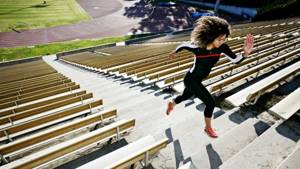
Let's calculate how many calories a person weighing 100 kg burns when climbing to the 9th floor on a staircase with a step height of 20 cm and 18 steps between two adjacent floors:
- Multiply the mass by 10. 100*10=1000.
- We multiply the resulting number by the height of the steps in meters (20 cm = 0.2 m). 1000*0.2=200.
- We multiply the resulting number by the number of steps between the two floors. 200*18=3600.
- Now we subtract 0.5 from the number of floors and multiply the result of the previous calculation by the resulting number. 9-0.5=8.5. 8.5*3600=30600. This is the amount of energy spent on lifting in joules.
- Let's convert it into calories. To do this, divide the result of the previous calculation by 4.2. 30600:4.2=7285 calories (approximately).
Since human energy consumption is calculated in kilocalories, we divide the resulting number by 1000. It turns out that while climbing to the 9th floor, a person weighing 100 kg spends approximately 7.3 kcal.
Is energy wasted during descent?
Once you reach the maximum floor, you will have to go back down. This also requires energy. But it is consumed 3 times less during descent than during ascent.
Example. Having climbed to the 9th floor and descended from it, a person weighing 100 kg spends approximately 10 kilocalories.
How many calories can you burn in one workout?

It all depends on the speed of movement on the stairs and the duration of the workout. Let's give 2 examples for the same person weighing 100 kg:
- Slow walking. Suitable for untrained people. For example, going up to the 9th floor and coming down from it takes 3 minutes. This means that in 30 minutes there will be 10 ascents and descents. Then 100 kilocalories will be consumed in half an hour, and 200 in an hour.
- Fast walking (almost running). Suitable for trained people with a strong cardiovascular system. For example, each descent and ascent takes 1 minute. Then in 30 minutes the person losing weight will rise and fall 30 times, and this is already 300 kilocalories, and in an hour – 600.
Be sure to read: Effective exercises for weight loss with fitball
You can burn about the same amount of energy while jogging or jumping rope.
The influence of the stepper on the human body
A stepper is a very popular exercise machine that is used to pump up certain muscles of the body. This device is a good cardio machine that simulates climbing stairs. It is mainly used for the purpose of losing weight, but its benefits are not limited to this:
- the heart and blood vessels are strengthened;
- the respiratory system develops;
- strengthens the muscles of the back, abs, buttocks;
- excess weight is lost;
- figure correction;
- improved coordination;
- stimulation of the metabolic process;
- increasing immunity.
There are three types of stepper:
- classic - imitates climbing stairs as accurately as possible;
- balancing - additionally develops coordination of movements and strengthens the abdominal muscles; when moving, the center of gravity of the body shifts in different directions;
- rotating - additionally loads the back, since when walking the body turns. This type with the maximum amount of load and works all the muscles of the body in 10 minutes.
Calorie consumption on a stepper
The number of calories burned depends on the intensity of the exercise. Approximate consumption is 500–600 kcal per hour. With a combination of exercise and proper nutrition, excess weight comes off quickly.
Nutrition for cardio training for weight loss
Cardio training is represented in many sports: cycling, swimming, jumping rope, brisk walking, aerobics, dancing, etc. Diet is an integral procedure that determines the effectiveness of exercise. If the exercises do not involve burning excess fat and body weight is within normal limits, then the diet does not involve serious restrictions. In this case, a normal healthy diet with a slight restriction of animal fats and light carbohydrates is sufficient.
Note! Cardio exercise awakens your appetite, and if you do not follow the diet, you can gain excess weight.
The diet during cardio training should include:
- animal proteins (beef, chicken breast, milk, fish) in a ratio of 60–70% of the daily diet;
- carbohydrates (cereals, cereals, vegetables, fruits) 20% of the daily value;
- vegetable fat (nuts, vegetable oil) at least 30 grams per day.
Important information! Reducing the number of calories (by more than 20%) during cardio exercise can lead to muscle tissue degeneration.
Nutrition after cardio training to burn fat
To achieve the desired result, you must follow proper nutrition before and after training. The main principle of nutrition is:
- carbohydrates - before training;
- proteins - after training.
You cannot exercise on an empty stomach, but you should eat food 1.5–2 hours before training.
Nutrition after exercise is important. Eating is allowed after half an hour.
- fast protein (whey protein, egg white);
- an hour later - protein, complex carbohydrates, fats (40x40x20).
Advice from trainers and nutritionists during exercise
Trainers and nutritionists recommend adhering to the following rules:
- You cannot limit your fluid intake so as not to provoke a change in water balance. Pure, unadulterated water is best.
- To maintain the required weight, you should be physically active (at least the amount of walking that prevails in everyday life).
- Cardio exercises should be accompanied by a set of strength exercises. Such conditions promote flexibility and the development of good coordination of movements. In order to lose weight, it is necessary to perform complex training.
- The daily diet should include all food groups: proteins, vegetable fats, carbohydrates, fruits and vegetables. It is important to focus more on fruits and vegetables.
- Do not take fat burners that contain guarana and caffeine. Given the current level of stress, such drinks can lead to nervous disorders and cardiovascular diseases.
- The shortest way to a slim figure is joint aerobic and strength exercises and a healthy diet.
If you want to exercise for the purpose of losing weight or strengthening muscles, 2 workouts per week is not enough. Only proper distribution of loads and a balanced diet will help achieve the desired result.
Benefits of walking up stairs for weight loss
There is no consensus among professionals regarding the benefits of such activities for absolutely all people seeking to achieve an ideal body. Walking up stairs to lose weight for an ordinary healthy person does not pose any danger, which cannot be said about people suffering from varicose veins in the legs and having injuries to the hip joints and knees. For this group, active climbing of stairs is extremely harmful to health . For people without these pathologies, walking up stairs is even very useful. Lifting has the following effects:
- increases the elasticity of the thighs, calves, buttocks;
- reduces the risk of developing pathologies of the heart and blood vessels;
- helps increase muscle mass;
- increases daily calorie expenditure.
What muscles work
Walking up the steps to lose weight helps strengthen almost all organs and systems of the body. Climbing stairs at a fast pace helps to effectively work out your abs, back, and buttocks. Separately, it is worth mentioning the hips. As a rule, when losing weight, this area is most susceptible to sagging, which can be avoided by climbing several flights of stairs every day. At the same time, you can improve the result by using dumbbells and special weights during exercise.

How many calories are burned
It is known that walking up the stairs is even more effective for weight loss than light jogging. In addition, during a climb, a person burns calories 10 times more intensely than when moving on a flat surface. It is important to note that energy is spent not only on the ascent, but also on the way back. When answering how many calories are burned when walking up the stairs, experts note that it all depends on the correctness and intensity of the training. On average, you can burn up to 700 kcal in an hour of active exercise .
Advantages and disadvantages of the method, contraindications
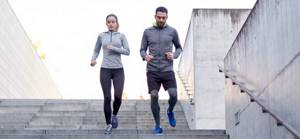
Advantages of losing weight by walking on stairs:
- Burns a lot of calories (more than walking, dancing and swimming).
- Fast weight loss. When you walk up stairs, fat is broken down and water is lost. This promotes rapid weight loss. In one workout you can lose 500-700 g of weight.
- Availability. You don't need to join a gym or hire a trainer. This is convenient if there is no forest park nearby in which you could run in the fresh air.
- Strengthening the cardiovascular system. Regular physical activity trains the heart muscle, so the heart begins to push a larger volume of blood in one contraction. At the same time, the number of blood vessels increases and their walls become stronger. And this is a good prevention of varicose veins.
- Increased endurance. Regular training increases a person's physical fitness. His body becomes more resilient. This allows him to gradually increase the time he walks on stairs to lose weight.
- Strengthening the muscles of the legs. After 2-3 workouts, you will notice that the muscles are noticeably tightened. And after 2-3 months, your legs will look athletic.
The disadvantages of walking up stairs for quick weight loss include:
- Lack of fresh air;
- Large load on the heart (dangerous for unprepared people);
- Heavy load on the knees and other joints of the legs;
- There are contraindications to this type of exercise.
Contraindications for walking up stairs to lose weight include:
- High blood pressure;
- Pregnancy;
- BMI (body mass index) above 33;
- Heart diseases;
- Varicose veins of the legs;
- Scoliosis (curvature of the spine);
- History of injuries (if you have previously had bone fractures, you should not overload your legs).
Be sure to read: How to exercise correctly and effectively on an elliptical trainer?
Before you start training, check your health and consult with your doctor.
How to walk up the stairs correctly
Each person should approach training individually, taking into account the parameters of their own body and its readiness for physical activity. In any case, it is better to start with short sessions. At the same time, do not forget about a light warm-up before walking up the stairs. In cases where there are minor health problems, you need to start with minimal loads.
At first, you should not highlight the obligatory ascent to the 9th floor on foot; it will be quite enough to climb 5 flights of stairs. At first, it is not even forbidden to use the elevator periodically if walking up the stairs is difficult. The load should also be increased gradually, focusing on how you feel during training. In addition, you need to pay special attention to your pulse: the optimal heart rate is between 140-150 beats per minute.
If you need to lose excess weight, it is advisable to do the exercise at an accelerated pace. You should exercise only in running shoes: this way you can prevent ankle injuries. With all this, in order to eliminate excess fat mass and give the body definition, you need to follow an extremely simple technique for walking up the steps:
- you need to climb calmly, overcoming each step step by step;
- the body must not be tilted to the side;
- the stomach should be pulled in while walking;
- It is recommended to perform movements with your hands that are typical for race walking;
- You can't hold on to the railing.
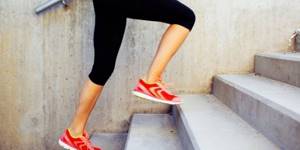
Climbing stairs
When choosing walking up stairs as a way to lose excess weight, do not forget that a slow pace helps maintain muscle tone, and a fast climb helps burn extra calories. Regardless of how quickly you climb stairs, it is extremely important to monitor your heart rate. If your heart rate exceeds 150 beats per minute, you should think about reducing the intensity of your training. It is important to note that walking on stairs for weight loss is contraindicated for persons with a body mass index of 30 and above .
How to descend correctly
During classes, do not forget about the basic rules and restrictions associated with performing the exercise. It is important to pay attention not only to the technique of ascent, but also descent. When walking down the stairs to lose weight, the back of the thigh is involved in the work, so if you walk along the steps on your toes, you can more effectively strengthen this area. In addition, it is better to precede the descent with a short pause. Returning to the starting point should not take less than 15 minutes.
Walking goals: where to start and how to walk correctly
Not a single successful project today would be implemented if its author did not have clear, understandable, achievable goals. In sports the situation is exactly the same. First you need to correctly assess your capabilities, and then establish the reasons why you need to walk up the stairs.
Her Majesty motivation
The most common option would be weight loss. How to properly find the motivation to start playing sports and switch to a proper balanced diet, there are already materials on our website. Set the right guidelines for yourself, but you don’t need to demand the unrealistic from yourself. Otherwise, an activity that does not bring visible fruit will not bring joy. Then people just give up and freak out.
You shouldn’t get hung up on numbers, but you should set goals that are truly achievable. For example, you can simply set a limit of 3-5 kilograms per week and strive for it. You can help yourself with incentives, such as buying a new dress a size or two smaller, a newfangled gadget, and similar pleasant little things. Thoughts about a well-deserved reward will push you to action, constantly pushing you forward.
Walking on stairs for weight loss: rules of fitness training
Any sports activity should be started according to your level of training.
- If there are health problems, then classes should be started with light loads. You should not conquer the ninth floor, like the top of Everest, with all your strength. Walk to the third, then you can walk to the fifth.
- It is not prohibited to use the elevator. If it gets difficult, do it.
- The walking pace should be increased slowly, gradually. You will always have to clearly control your feelings.
- During weight loss exercises, training should be as intense as possible.
- Check your pulse often, especially if it becomes difficult. It should stay within 140 or 150 strokes.
- It is not advisable to stop at the top of the climb; it is better to descend first for the second approach. Below you can take a break for a few seconds.
- You need to walk up the stairs so that your breathing is quite rapid, but not out of breath. Yes, you should talk calmly while driving.
- You can move up at any speed; some acceleration is even welcome. It is better to go down slowly and measuredly. A fast pace of descent can put extra stress on your joints, which is not necessary.
Delicious recipe! Indoor roses are withering, what to do?
For exercise, you need to choose comfortable running shoes of the appropriate size. This will prevent the possibility of slipping, increasing safety.
How to walk up the stairs to pump up your buttocks
In order for the butt to become beautiful, toned, and elastic, you need to provide weight to the muscles. For this, several dumbbells weighing two or three kilograms may be useful. For the most prepared, you can take four-kilogram weights.
- To avoid injuring your knee joints, which often affects even professional athletes, warm them up thoroughly before training on the stairs. Stretching exercises or exercise on an exercise bike are great options.
- Always choose non-slip shoes, otherwise training your buttocks can become a dangerous activity.
- If the street version of steps is available to you, then it is better to start with it, and not with the stairs in the entrance. Outdoor exercise is always more beneficial, but simply avoiding the elevator will do.
- Take small dumbbells in your hands for weights. At first it may seem that 1-3 kilograms is clearly not enough. However, by the third flight you will realize that the weight increases with each new step. There is no need to immediately tear yourself out of your tendons. Only after getting used to the low weight can you increase it.
- When starting to lift, keep your arms with weights semi-relaxed and lowered along your body.
- Just like when walking to lose weight, you should not give yourself rest at the top point of the ascent. That is, having set a “ceiling” for yourself, for example, the third or fifth floor, you need to turn around and go down. There you can take a break for a couple of seconds. The descent always seems easier, but the muscles work no less intensely. Therefore, it will be easier and faster to pump up your buttocks if you just rest below.
- Your feelings should be an indicator of when it is time to stop exercising. When it becomes difficult to control your legs and hips, it’s time to call it a day.
After such exercises, painful sensations usually appear that do not go away for up to 2-3 days. This is quite normal, you can use warming ointments, do light exercises, and do exercises. Optimally intensive exercises for pumping the buttocks should be carried out only 2-3 times a week, alternating with regular lifts without weights; this will be quite enough to see the fruits of your labor in just two weeks.
How to walk up stairs correctly: common mistakes
It is very important to walk up the steps, following the correct technique, in order to completely eliminate even the possibility of injury. Clinging to the railing, pulling yourself up with your arms, bending your body to either side, or putting your head down or slouching is not a good idea. But there are other, quite typical mistakes for many that prevent you from pumping up your butt using a regular ladder.
- You cannot take the walking pace too high from the start. If you can't stand it for twenty minutes, then it's too much for you. Just reduce the intensity, repeat again.
- You will have to move smoothly, slowly transferring your weight to your supporting leg. You cannot “jump” on steps or jump over them, because your goal is not at all the fastest ascent.
- As already mentioned, do not “crawl” along the railings, this will lead to the leveling of all your work. Such activities will not be of any use.
- It is not recommended to chat while climbing. It’s even better to breathe through your nose, like when running.
Wearing unsuitable shoes can result in injuries to the ankle and other parts of the body. Even if there are no special running shoes, it is better to choose something non-slip, for example, comfortable tennis shoes or bowling shoes.
A simulator that simulates walking on stairs
People who prefer to work out in the gym speak very positively about this type of device. As a rule, imitation of walking on stairs for weight loss occurs through the so-called climber, but there may be other options with the name of the projectile. This device looks extremely simple: two pipes with pedals and a time sensor. It is important to note that the climber is one of the most effective cardio equipment. Exercising on it helps you burn even more calories than jogging . Other advantages of the climber include:
- development of the correct dynamic stereotype;
- absence of a “light phase”;
- reducing the risk of ankle injury;
- the opportunity to exercise in the comfortable conditions of the gym;
- the presence of handrails to help maintain balance.
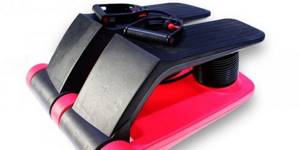
How to exercise on a stepper correctly to lose weight
You can train with this simple device at home. A stepper is essentially a mini apparatus consisting of two closely spaced pedals. At first, performing exercises on this unit is unusual and even dangerous. Therefore, before exercising, make sure that you can maintain your balance while pressing the pedals. If this is difficult for you, try connecting harnesses to your training by threading them through special holes on the stepper. This will make it easier to maintain balance, which will significantly increase the number of repetitions.
When answering how to properly exercise on a stepper for weight loss, instructors first of all draw the attention of novice athletes to the fact that they will have to train regularly. So, for active weight loss, it is recommended to conduct daily half-hour walking sessions on a stepper. In addition, it is important to follow a simple rule: do not eat an hour and a half before and after training. With regular exercise, the result is visible after a week.
Various training programs
You can experiment, complicate, and make your exercises on the stairs more difficult ad infinitum. The main thing is not to jump from stage to stage, so as not to get injured. To do this, it doesn’t hurt to correctly evaluate your own preparation and act accordingly.
For newbies
Those who have just started walking up flights of stairs should not immediately overload their body. You can take as many weights with you as possible, and it is better to make sure that they have a minimum weight (1-2 kilograms). It is also not necessary to pull dumbbells in your hands. You can simply put them in a backpack and put it on your shoulders. If you don't have dumbbells, plastic bottles filled with water or sand will help.
- For 7-14 days you need to adhere to a reduced pace of classes. The total training time should be no more than 10-20 minutes.
- Over the next two weeks, the pace can be slightly increased. For example, you can first practice running for five minutes, and then continue walking for another 10-15 minutes.
This is quite enough to get involved and get used to the new loads. After a month, you can make your training more intense to consolidate the results and improve your performance.
For athletes
After about a month of classes at the initial level, “creativity” can be included in the classes. That is, light physical exercise is added to the usual steps. Don't forget that before the first difficult lesson, a good warm-up won't hurt. Two or three flights of stairs will be a good basis for future training.
- Jumping (both up and down).
- Running up the stairs (without skipping steps).
- Lifting on tiptoes or heels.
- Long, elongated steps every 2-3 steps.
- Raises on arms and legs.
- Cross lifts.
All these exercises can be done as a complex during each workout, performing only 2-3 approaches. But it’s better to make a plan from the beginning and add them to the list. In this case, it would be best to perform cycles 3-5 times in a row, resting at the bottom to restore breathing.
For advanced
A well-developed physically person can withstand much heavier loads than a beginner or even someone who has been practicing for some time. Therefore, their level must be appropriate for the classes to produce results. First, do your usual warm-up or go up and down two or three flights.
- Run up the steps for 1-2 minutes.
- Jumping from a squat towards the top.
- Straight and reverse push-ups on steps.
- Uneven-high side squats.
Any cycle must be repeated 3-5 times to achieve the effect of the exercises. If this doesn’t seem enough to you, then you can increase the load by adding additional cycles-approaches.
Simulators that simulate walking up stairs: what to look for
Today the market offers hundreds of different exercise machines. For example, comfortable steppers can be an excellent alternative to steps. This is usually a good solution at home. It comes with instructions and makes it easy to set the load level. These are cardio machines that simulate a person climbing stairs. During exercise, the same muscles are involved, so you can pump up your buttocks, lose excess weight, make your legs and butt more beautiful and sculpted.
- There are two main classes of steppers: standard size and mini version. Everything will depend on your preferences and capabilities. The second option is much cheaper and more compact in size.
- Classic exercise machines are chosen by those who want to accurately simulate climbing stairs.
- Balance steppers are more complex, and their platform moves, forcing the athlete to maintain balance. Therefore, many more muscle groups work, for example, the back and abdominal muscles are connected.
- Rotating devices allow you to train not only your legs, hips, buttocks, but also your back muscle corset.
There are many different design differences between exercise machines. For example, there are three main types: folding, professional, autonomous. They can be electrical or mechanical, or they can be portable, that is, powered by batteries. The most popular, widespread models create loads using hydraulics or pneumatics.
Contraindications for walking on stairs
The positive aspects of training are described above, but it is also worth paying attention to the negative aspects. Not everyone is suitable for such activities, so it is recommended that you first go to your doctor, get tested, and undergo tests. Only after this can you start this sport. So what are the contraindications, what should you pay attention to first.
- Inflamed joints will become an insurmountable barrier to such training. Even if there were no problems previously, sharp pain in the joints, clicks, unpleasant sensations, some kind of squeaks, all this should force you to consult a doctor and immediately stop training.
- Thrombophlebitis, thrombosis in different stages.
- Hypertension.
- Bronchial asthma, other respiratory tract pathologies.
- Cardiovascular diseases.
- Late pregnancy.
Delicious recipe! How to please a Leo man and keep him
After serious injuries or surgery, it is not advisable to begin this type of training until complete recovery. This can make the problems worse, which is completely unnecessary.
In conditions of modern physical inactivity, the human body gradually moves from an acceptable motor mode to an unacceptably limited one, which leads to excess weight gain. Daily walking on the stairs for weight loss, which involves slowly climbing the steps, will help burn extra calories and return your figure to its former parameters. Learn how to perform this exercise correctly to achieve maximum results.
Reviews
I decided to regain my former volumes by walking up the stairs. We managed to do this after 10 days of intensive training. I trained in the park, not far from my house. At first it was difficult to do even 2-3 repetitions, but then the body got used to the load, and the process began.
The doctor advised me to take the stairs to strengthen my cardiovascular system. In addition to the fact that this exercise is good for health, it is also a great way to preserve your waistline. So, an hour of walking burns about 500 calories, which is equivalent to eating cutlets for lunch.
The obvious advantages of the elliptical trainer
to burn calories
There are graphs of energy consumption, in the compilation of which a variety of types of activity were studied - from working with a vacuum cleaner to swimming fast crawl and jogging. When analyzing these processes, the ratio of calories we lose per 1 kg of our weight in 60 minutes is calculated and a “rating” of types of activity that bring maximum benefit to a person is determined.
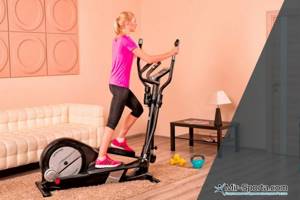
Training on an orbit track (ellipsoid) is considered one of the most effective. And why? Such a simulator, due to its versatility and delicate effect on the body, allows us to exercise for a long time, correlating our desires with our capabilities.
We don’t “kill ourselves” on the elliptical, we take care of ourselves, we don’t injure the spine, lower back, knees, and we don’t switch off from the process for as long as possible.
And again we ask the question - why? Happens:
Strengthening the cardiovascular system
On a treadmill or on a bicycle, according to statistics, people are more likely to quit the race. This is our psychology: “I will run 1 hour on the first day, and on the second day I will run 2 hours, and on the third...”. There will not be a third day, because you may fall down with a hypertensive crisis or tachycardia.
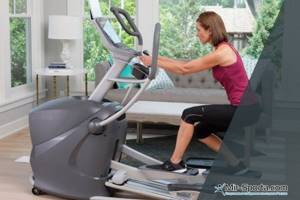
This will not happen with an ellipsoid. If you approach your training correctly, starting with 5-10 minutes, pausing (training every other day) and adding 5 minutes to your training every day, then you will help your heart and blood vessels become stronger, thereby preventing heart attacks and strokes.
Improving the respiratory system
It is important for people who last played sports at school to start training on the orbitrack, because this particular simulator does not increase the volume of the lungs (which in some cases can be dangerous), but trains the respiratory system, making us forget about shortness of breath when climbing to the 5th floor . You are much less likely to experience dizziness during your workout, fall off the machine, and get injured than with a treadmill that constantly moves. This is a definite plus. The lungs function by strengthening gradually, without stress.

Comprehensive muscle training
We could limit ourselves to a short phrase that the ellipsoid gives load to all muscle groups. But we will continue by saying that this load is delicate and beneficial for the body. The arms and legs are loaded to a reasonable extent (it is the orbitrack that makes it possible to pump the back of the thigh in reverse rotation mode, which a treadmill or exercise bike will not allow you to do). There is a load on the shoulders, but at the same time they do not become “bloated”, like those of bodybuilders. There is a load on the back, but it is gentle and pain occurs extremely rarely. The chest and abs are worked out. Miracle! We started with the question of how many calories are burned on the ellipse, and came to the conclusion that the functionality of this device is not limited to simply “destroying” the “calorie intake” consumed per day. It gives health and development.











